We use water not only for drinking but also for many other activities in our day to day life.
The amount of water we use for a work varies. We may use a mug of water for washing our face, a glass of water to drink, a pot of water to cook food, a bucket of water to bathe etc.
Water is not only needed for the activities mentioned above. In fact water is also need to grow crops and plants. Water is used in industries for producing almost all the things that we use. So, we need water not only for our daily activities but also for producing many things.
If you can make a note of the amount of water used by a person, we can calculate the amount needed by the family and then the whole village or town.
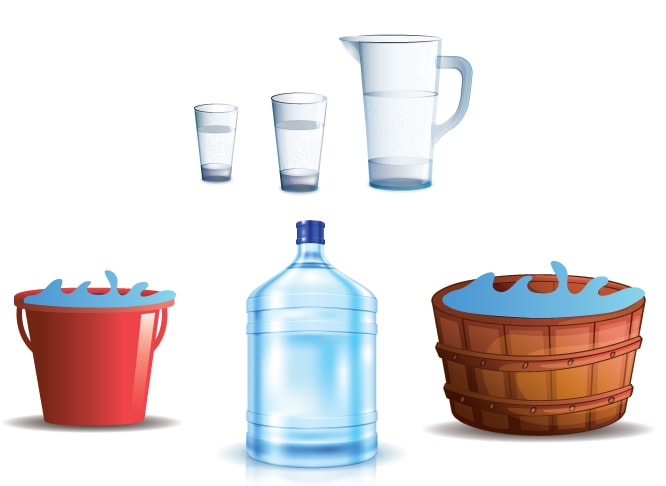
Some of us get the water from a river, spring, pond, well, a hand pump or a tap. The water we get from the taps is also drawn from some other water body like the river or a pond. And then it is supplied to the households through the network of pipelines. Now-a-days people also buy drinking water cans due to the scarcity in some regions.
Each of us may be getting water into our homes in different ways. But finally, all of us get water from the same sources such as ponds, lakes, rivers and wells. But from where do these water bodies like river, pond and lakes get water.
It is important to note that about two thirds of the earth is covered with water. And most of this water is in form of oceans and seas. But the water in the oceans and seas has many salts dissolved in it or in other words the water in oceans and seas is saline. So, it is not fit for drinking and other domestic, agricultural and industrial needs.
Still oceans play an important role in supplying the water we use. But did you notice that the water we drink is not salty. Moreover many of us live far away from the oceans. The oceans and seas help in supplying water for us through the WATER CYCLE.
Water disappears from wet clothes as they dry up. Water from fields, flower pots, wet roads, rooftops and a few other places also disappears after the rains. This is due to the evaporation of water. EVAPORATION is the process of converting water into vapor. And heating is required for the process of evaporation to occur.
During the daytime, sunlight falls on the land and water bodies. As a result, water from all these places continuously changes into vapour. Also the air surrounding us gets heated up due to the sunlight during day time. This warm air provides heat for evaporation of water in the shade. Thus, evaporation takes place from all open surfaces of water. Consequently, water vapour is continuously added to air.
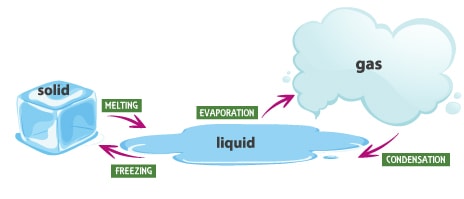
Clouds are formed due to the process of CONDENSATION. Condensation plays an important role in bringing water back to the surface of earth. As we go higher from the surface of the earth, it gets cooler. When the air moves up, it gets cooler and cooler. At sufficient heights, the air becomes so cool that the water vapour present in it condenses to form tiny drops of water called droplets. It is these tiny droplets that remain floating in air and appear to us as clouds.
Sometimes many droplets of water come together to form larger sized drops of water. These drops of water become so heavy that they begin to fall as rain or hail or snow. Thus, water in the form of vapour goes into air by evaporation and transpiration then it forms clouds and finally comes back to the ground as rain, hail or snow.
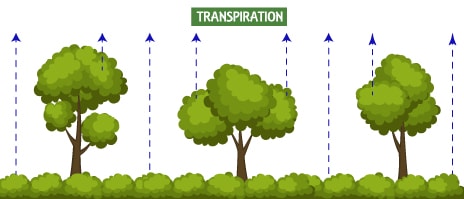
We all know that plants need water to grow. A part of this water is used by the plant to prepare its food. A part of water is also stored in various parts of the plant. Remaining water is released by the plants into the air as water vapor through the process of TRANSPIRATION. Hence, Water vapour enters the air through the processes of evaporation and transpiration.
Rain, snow and hail bring back water to the ground. As almost all land surfaces are above the level of oceans, most of the water that falls on the land sooner or later goes back to the oceans. This happens in many ways:
Snow in the mountains melts into water. This water flows down the mountains in the form of streams and rivers.
Rainwater also flows in the form of rivers and streams. Most of the rivers cover long distances on land and ultimately fall into a sea or an ocean. During this process much of the rainwater gets absorbed by the ground into the soil and becomes available as ground water. Some of this water is brought back to the air by the process of evaporation and transpiration.
Open wells are fed by ground water. Ground water is the source for many lakes. Ground water is drawn by a hand pump or a tube well. The more hand pumps or tube wells that are used in an area, the deeper we need to dig to find this ground water. Consequently, ground water is been overused.
In areas where the land has little or no vegetation, the rainwater flows away quickly. Moreover flowing rainwater takes the top layer of the soil away with it. In few areas most of the land is covered with concrete. This reduces the seepage of rainwater into the ground which ultimately affects the availability of ground water.

Water brought back to the surface of the earth by rain, hail or snow, goes back to oceans. Thus, water from the ocean and surface of the earth goes into air as vapour; returns as rain, hail or snow and finally goes back to the oceans. The circulation of water in this manner is known as the WATER CYCLE. This circulation of water between ocean and land is a continuous process. This maintains the supply of water on land.
The time, duration and the amount of rainfall varies from place to place. In some parts of the world it rains throughout the year while there are places where it rains only for a few days.
In our country, most of the rainfall occurs during the monsoon season. Rains bring relief especially after hot summer days. The sowing of many crops depends on the arrival of monsoon.
Heavy rains may lead to rise in the level of water in rivers, lakes and ponds. The water may then spread over large areas causing floods. The crop fields, forests, villages, and cities may get submerged by water. In India flood causes extensive damage to crops, domestic animals, property and human life.
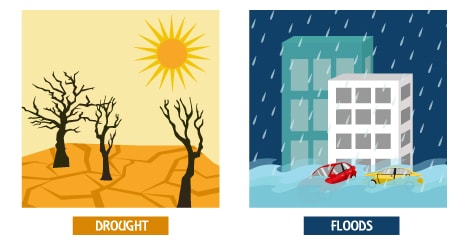
If it does not rain in a region for a year or more, the soil continues to lose water by evaporation and transpiration. Since it is not being brought back by rain, the soil becomes dry. The level of water in ponds and wells of the region goes down and some of them may even dry up. The ground water may also become scarce. This may lead to drought.
In drought conditions, it is difficult to get food and fodder. People and animals would not have enough food and water. Even there would not be any water to grow crops.
As discussed earlier, only a small portion of the water is available for use by plants, animals and humans. Most of the water is in the oceans and it cannot be used directly. When the level of the ground water decreases drastically, this cannot be used any more.
The total amount of water on Earth remains the same, but, the water available for use is very limited and is decreasing with over usage.
The demand for water is increasing day-by-day. The number of people using water is increasing with rising population. In many cities, long queues for collection of water are a common site.
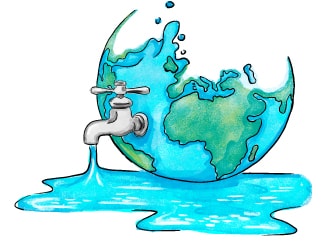
Also, more and more water is being used for producing food and by the industries. These factors are leading to shortage of water in many parts of the world.
Hence, it is very important that water is used carefully. We should not waste water.
We must also increase the availability of underground water. One way of increasing the availability of water is to collect rainwater and store it for later use. Collecting rainwater in this way is called rainwater harvesting. The basic idea behind rainwater harvesting is “Catch water where it falls”.
Generally, the rainwater that falls in places that are mostly covered with concrete roads and buildings flows into the drains. And from there it goes to rivers or lakes. A lot of effort will be required to get this water back into our homes as the water did not seep into the ground.
The following are the two techniques of rainwater harvesting:
Link to Solutions on this topic
- Share with your friends! -
Login to post your comment here...
- or with social Account -